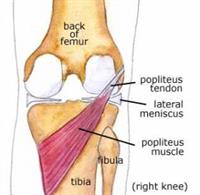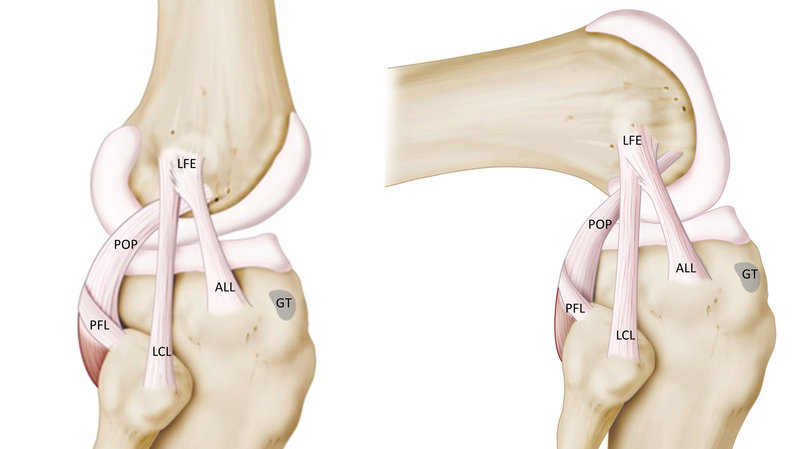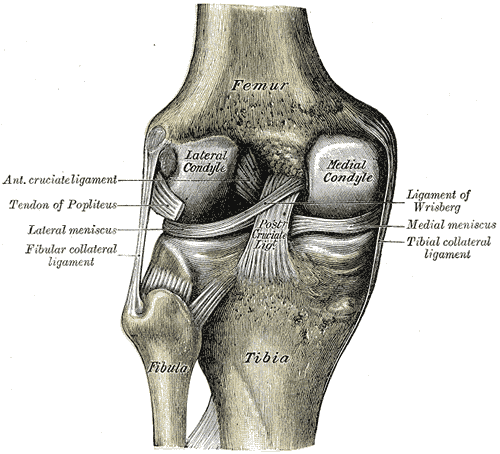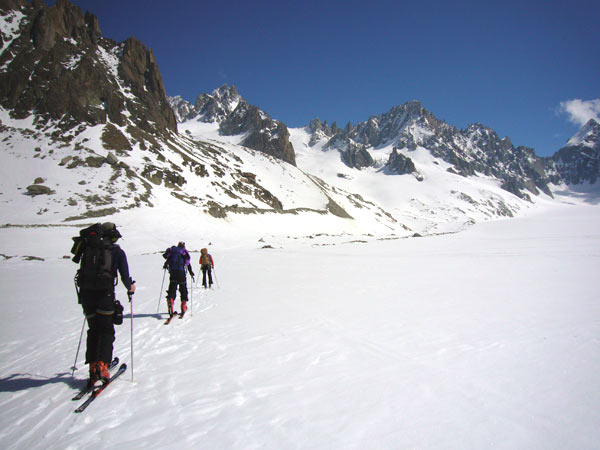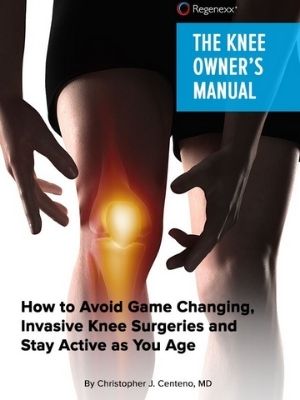Outside Knee Pain
Get Help With Outside Knee PainWhat causes outside knee pain? How do you treat it? Let’s go over all of this and also review how one patient avoided a huge surgery.
What’s On the Outside of the Knee?
You have a couple of key structures here (1). They include the:
- Lateral meniscus
- Lateral joint compartment
- Popliteus tendon
- Iliotibial band
- Lateral collateral ligament and anterolateral ligament
- Fibula
How Outer Knee Pain Happens
Lateral meniscus
The meniscus is a figure-8 shaped fibrous structure (shown here from above) that is a shock absorber for the knee joint. It has an outside part (lateral meniscus) that cushions the joint. The meniscus can become torn or degenerated. If you’re young, then a meniscus tear is more likely to cause pain. For patients over 35, it’s less likely that a meniscus tear is causing the pain (11). However, in either instance, a meniscus that isn’t doing its job may be causing the cartilage and bone to degenerate and cause outside knee pain.
Lateral Joint Compartment
The lateral joint compartment is the outside of the knee joint where the thigh bone (femur) meets the leg bone (tibia). There is cartilage here and when you start to lose cartilage and get bone spurs, this is called arthritis which can cause outside knee pain. In this case, this is called lateral compartment knee osteoarthritis.
Iliotibial Band & Popliteus Tendon
There are two tendons on the outside of the knee including the terminus of the Iliotibial Band (aka the ITB) where it inserts into tibia as well as the popliteus tendon. The ITB begins on the outside of the pelvis and hip and travels down the outside of the leg. See my video below to find out more about that structure. If you have chronically tight ITB’s, this can eventually cause painful tendinopathy here. Another tendon that can cause outside knee pain is the popliteus which has its muscle belly on the back of the knee (see image here). This tendon can get damaged or beat up as well.
LCL & ALL
There are also two critical ligaments on the outside of the knee. One is the Lateral Collateral Ligament or LCL, which acts as the duct tape on the outside of the knee and stabilizes this area. The Anterolateral Ligament (ALL) is also on the outside of the knee and stabilizes this area and helps the ACL ligament (see the image to the right). These ligaments can be sprained or torn.
Fibula
Finally, the fibula is the outside knee bone that attaches to the main leg bone (tibia) via strong ligaments. The bone can become bruised or the ligaments that hold it in place can become injured. Finally, there is a small joint between the fibula and tibia and this joint can become arthritic.
Conditions We Treat Associated with Outer Knee Pain
Baker’s Cyst
A Baker’s cyst can cause knee pain. A Baker cyst is swelling caused by fluid from the knee joint protruding to the back of the knee. They are NOT a true cyst since it has communication with the synovial sac. They typically arise from degenerative changes or injury to the articular cartilage (arthritis) or meniscus. At the Centeno-Schultz Clinic, we believe that baker’s Cysts are simply a barometer of the health of the knee joint. In a healthy knee, there are absent whereas with injury and degenerative changes they are common. They arise between the tendons of the medial head…
Read More About Baker’s CystBone Spurs In The Knee
Bone spurs, also known as osteophytes, are abnormal growths that can form along any bony surface in the body. They most frequently occur where tendons and ligaments attach to the bone. As a result, they are more commonly seen in large mobile joints that support weight, such as the hips, spine, ankles, or knees. Surprisingly, most bone spurs are relatively benign but are a clinical sign of instability in the area. Research demonstrates that if a ligament has laxity, the constant strain at the insertion into the bone will elevate the surface of the bone, creating additional bone formation – this is known as a traction osteophyte.
Read More About Bone Spurs In The KneeEhlers-Danlos Syndrome (EDS)
Disorders that affect and weaken the connective tissues such as tendons and ligaments. It is a hereditary disorder which means you are born with it. EDS has many different signs and symptoms which can vary significantly depending upon the type of EDS and its severity. It most commonly affects the skin, joints, and blood vessels. Joints are typically hypermobile with excessive joint range of motion because of a defect in collagen formation. In most cases Ehlers-Danlos syndrome is inherited. That is to say that you are born with it. The two main ways EDS is inherited are: autosomal dominant inheritance and autosomal recessive inheritance…
Read More About Ehlers-Danlos Syndrome (EDS)Iliotibial Band Syndrome (ITBS)
Also known as “IT Band Syndrome” also known as “ITB Syndrome,” iliotibial band syndrome is a painful medical condition that affects the lateral hip, leg, and knee. It can affect individuals of all ages and most often is caused by repetitive activities like running, cycling, hiking, and walking. Your iliotibial band is a thick band of connective tissue that runs from the outside of your hip down to the outside aspect of your knee. Its principal function is to stabilize the hip and knee. If it becomes tight and dysfunctional, you may experience pain along with this band of tissue due to strain or inflammation. You may also experience pain, limited range of motion in…
Read More About Iliotibial Band Syndrome (ITBS)Knee Arthritis
In the human body, a joint is simply where 2 ends of bone come together. At the ends of these bones, there is a thick substance called “Hyaline Cartilage” that lines the ends. Hyaline cartilage is extremely slippery which allows the two ends of the bone to slide on top of each other. Then there is a capsule that connects the two ends filled with “synovial fluid” that acts as a further lubricant to make it more slippery! Arthritis in the knee is defined by loss of the hyaline cartilage plus other changes that happen to the bone such as additional bone being laid down (bone spurs/osteophytes). The cartilage layer is worn down to the point of exposing the underlying bone they cover…
Read More About Knee ArthritisLCL Sprain
What is an LCL Sprain? A strain or tear to the lateral collateral ligament (LCL) is known as an LCL injury. The LCL is a band of tissue that runs along the outer side of your knee. It aids in keeping the bones together while you walk, ensuring that your knee joint remains stable. How you feel and what type of treatment you’ll require depends on how severely your LCL has been stretched or torn. If it’s only a minor sprain, self-care at home might help. However, if it’s a significant tear or sprain, you may need physical therapy, an injection-based procedure, or surgery….
Read More About LCL SprainLCL Tear
A strain or tear to the lateral collateral ligament (LCL) is known as an LCL injury. The LCL is a band of tissue that runs along the outer side of your knee. It aids in keeping the bones together while you walk, ensuring that your knee joint remains stable. How you feel and what type of treatment you’ll require depends on how severely your LCL has been stretched or torn. If it’s only a minor sprain, self-care at home might help. However, if it’s a significant tear, you may need physical therapy, an injection-based procedure, or surgery. Orthopedists categorize LCL tears into 3 grades…
Read More About LCL TearMeniscus Tears
The meniscus is a c-shaped piece of cartilage in the knee that functions as an important shock absorber. It is sandwiched between the thigh and shin bone. There are two menisci per knee. One on the inside portion of the knee (medial) one on the outside aspect (lateral). The knee meniscus is susceptible to injury. The most common injury is a tear in the meniscus. Not all meniscus tears however cause pain. When symptomatic a meniscus tear can cause pain, swelling, and restriction in range of motion. Tears in the knee meniscus can arise from trauma or degeneration. There are many different types of meniscus tears based upon locations….
Read More About Meniscus TearsPatellofemoral Pain Syndrome
Patellofemoral pain syndrome (PFS), also called runner’s knee or retropatellar pain syndrome, is a significant cause of pain in the front of the knee. The pain is usually experienced behind or around the patella (kneecap) when the knee is bent or fully loaded. This post discusses everything you need to know about patellofemoral pain syndrome.
Read More About Patellofemoral Pain SyndromePeroneal Nerve Injury
The common peroneal nerve branches behind the knee and this could be irritated from any overuse activity, surgery, instability, or any compression on the outside of the knee. Typically, this will present as pain on the outside of the knee radiating towards the baby toe, the calf, and the lateral shin towards the lateral ankle. What Causes Peroneal Nerve Compression? There are many potential causes of peroneal nerve compression, such as overuse activities, surgery, instability, or any compression on the outside of the knee. Trauma and nerve compression, especially caused by a fractured or dislocated ankle, can all cause injury to the peroneal nerve. Causes include:
Read More About Peroneal Nerve InjuryHow do you Treat Outside Knee Pain?
Treating outside knee pain all depends on the cause. Oftentimes just rest or physical therapy is the answer, but if not, let’s review some state of the art treatments:
Lateral meniscus
Tears in the outside meniscus that don’t respond to physical therapy are often treated surgically by cutting out the torn part (partial meniscectomy). However, recent research has shown this procedure to be no better than placebo or physical therapy, so there is no evidence that this surgery helps, despite its common use (2). Recently, research on platelet-rich plasma injections into the torn meniscus has shown this to be a promising treatment (3).
Lateral compartment knee arthritis
Physicians will often want to inject steroids to help reduce pain and improve swelling, but we now know these shots kill off knee cartilage (4). Other options, if you have mild to moderate arthritis, include hyaluronic acid (HA), which is a lubricating gel or prolotherapy (prolo) which is a shot that causes a brief inflammatory healing response (5). Another injection that has been shown to be better than HA or prolo is platelet-rich plasma (PRP). Finally, if the arthritis is more severe, bone marrow stem cell injections have shown promise (6). If nothing else less invasive works, partial knee replacement is often recommended.
ITB and Popliteus Tendon‘
The Iliotibial band can often be treated by rolling it out with a foam roller which can improve circulation (7). If this or physical therapy doesn’t help, in my experience a PRP injection can often help heal the ITB or popliteus tendon.
Lateral Collateral Ligament or Anterolateral Ligament
These can be injured with trauma or wear and tear and can make the outside of the knee unstable. If these ligaments are sprained, then bracing as well as physical therapy to try to strengthen muscles is usually prescribed. If this fails, both of these ligaments can be surgically reconstructed (8,9), but we often find that a PRP injection can help and tighten them without having to rip out the existing ligament.
Fibula
If this bone is bruised, this often takes weeks to months to heal. However, the ligaments that hold it in place can also be damaged and in my experience, these usually respond well to prolotherapy or platelet-rich plasma.
Fixing Outside Knee Pain to Ski the Haute Route in the Alps
The Haute Route is a 125-mile long, high mountain trail connecting Chamonix with Zermatt that takes seven days to ski with 43,000 feet of vertical. It was the dream of a patient of mine from Atlanta to make this trek on skis. However, in 2012 he was told that needed a knee replacement. However, this type of route would never be compatible with that procedure, hence he went looking for other options and found our clinic. Due to the severity of his knee arthritis, he was taken down to an advanced practice site in Grand Cayman where we can use culture-expanded stem cells derived from his bone marrow (10). In 2015 he skied the Haute Route in 6 days having never had that knee replacement! He’s now back for a tune-up treatment at 7 years after his initial knee stem cell injection.
The upshot? There are many things that can cause outside knee pain. Most will heal on their own. However, if they don’t heal, I would recommend using newer interventional orthopedics techniques rather than older surgical techniques!
_________________________
References:
(1) Schweller EW, Ward PJ. Posterolateral Corner Knee Injuries: Review of Anatomy and Clinical Evaluation. J Am Osteopath Assoc 2015;115(12):725–731. doi: 10.7556/jaoa.2015.148.
(2) Sihvonen R, Paavola M, Malmivaara A, et al. Arthroscopic partial meniscectomy versus placebo surgery for a degenerative meniscus tear: a 2-year follow-up of the randomised controlled trial. Ann Rheum Dis. 2018;77(2):188–195. doi:10.1136/annrheumdis-2017-211172
(3) Kaminski R, Maksymowicz-Wleklik M, Kulinski K, Kozar-Kaminska K, Dabrowska-Thing A, Pomianowski S. Short-Term Outcomes of Percutaneous Trephination with a Platelet Rich Plasma Intrameniscal Injection for the Repair of Degenerative Meniscal Lesions. A Prospective, Randomized, Double-Blind, Parallel-Group, Placebo-Controlled Study. Int J Mol Sci. 2019;20(4):856. Published 2019 Feb 16. doi:10.3390/ijms20040856
(4) McAlindon TE, LaValley MP, Harvey WF, et al. Effect of Intra-articular Triamcinolone vs Saline on Knee Cartilage Volume and Pain in Patients With Knee Osteoarthritis: A Randomized Clinical Trial. JAMA. 2017;317(19):1967–1975. doi:10.1001/jama.2017.5283
(5) Arias-Vázquez PI, Tovilla-Zárate CA, Legorreta-Ramírez BG3 Burad Fonz W, Magaña-Ricardez D, González-Castro TB, Juárez-Rojop IE, López-Narváez ML. Prolotherapy for knee osteoarthritis using hypertonic dextrose vs other interventional treatments: systematic review of clinical trials. Adv Rheumatol. 2019 Aug 19;59(1):39. doi: 10.1186/s42358-019-0083-7.
(6) Centeno C, Sheinkop M, Dodson E, et al. A specific protocol of autologous bone marrow concentrate and platelet products versus exercise therapy for symptomatic knee osteoarthritis: a randomized controlled trial with 2 year follow-up. J Transl Med. 2018;16(1):355. Published 2018 Dec 13. doi:10.1186/s12967-018-1736-8
(7) Okamoto T, Masuhara M, Ikuta K. Acute effects of self-myofascial release using a foam roller on arterial function. J Strength Cond Res. 2014 Jan;28(1):69-73. doi: 10.1519/JSC.0b013e31829480f5.
(8) Grawe B, Schroeder AJ, Kakazu R, Messer MS. Lateral Collateral Ligament Injury About the Knee: Anatomy, Evaluation, and Management. J Am Acad Orthop Surg. 2018 Mar 15;26(6):e120-e127. doi: 10.5435/JAAOS-D-16-00028.
(9) Sonnery-Cottet B, Daggett M, Fayard JM, et al. Anterolateral Ligament Expert Group consensus paper on the management of internal rotation and instability of the anterior cruciate ligament – deficient knee. J Orthop Traumatol. 2017;18(2):91–106. doi:10.1007/s10195-017-0449-8
(10) Centeno CJ, Schultz JR, Cheever M, Freeman M, Faulkner S, Robinson B, Hanson R. Safety and complications reporting update on the re-implantation of culture-expanded mesenchymal stem cells using autologous platelet lysate technique. Curr Stem Cell Res Ther. 2011 Dec;6(4):368-78. https://www.ncbi.nlm.nih.gov/pubmed/22023622
(11) Englund M, Guermazi A, Gale D, et al. Incidental meniscal findings on knee MRI in middle-aged and elderly persons. N Engl J Med. 2008;359(11):1108–1115. doi:10.1056/NEJMoa0800777


